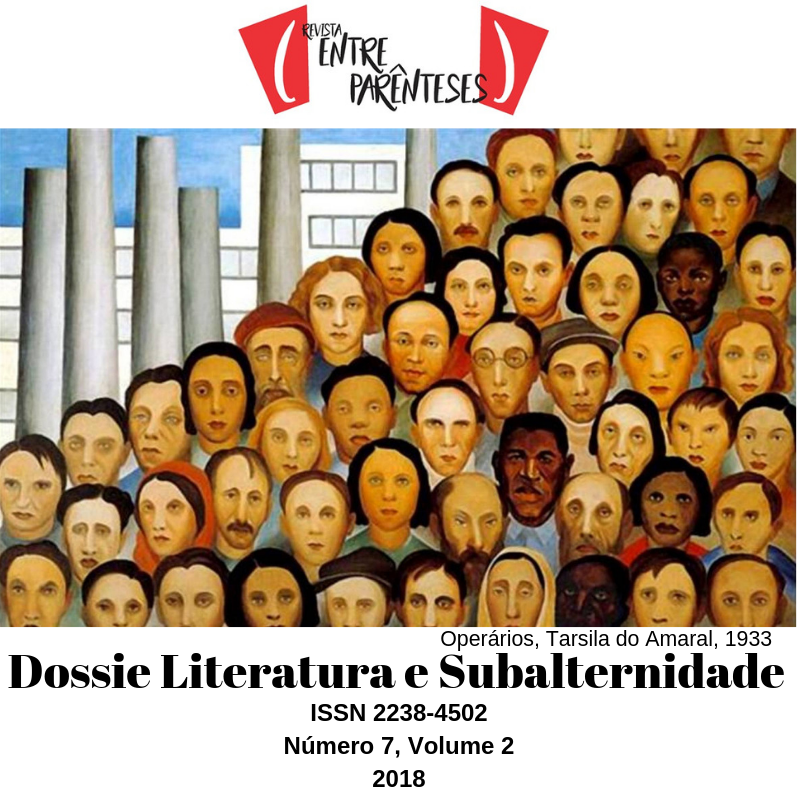“NOBODY PAID US ANY ATTENTION, SO WE PAID VERY GOOD ATTENTION TO OURSELVES”: GIRLHOOD IN TONI MORRISON’S THE BLUEST EYE
DOI:
https://doi.org/10.32988/rep.v2i7.750Palavras-chave:
Literatura norte-americana, Literatura afro-americana, Toni MorrisonResumo
This article analyzes Toni Morrison’s The Bluest Eye in order to demonstrate how the age, gender and race of the main characters influence the narrative and in fact make the story what it is. The analysis is based on the idea of ritualistic violence discussed in Azevedo (2001), the common denominators of American childhood listed by Mintz (2009), the significance dolls have in American girlhood, as explored by Jacobs (2008), and the characteristics commonly found in transitional chapter books specifically about African American young girls discussed by McNair and Brooks (2012). The article demonstrates the ways in which these factors work together in shaping the lives of the three young girls that are in the center of the narrative.Referências
AZEVEDO, Mail Marques de. Stereotypes of Persecution in Toni Morrison's The Bluest Eye. In: TORRES, Sonia (Ed.). Raízes e Rumos: Perspectivas Interdisciplinares em Estudos Americanos. Rio de Janeiro: 7letras, 2001. p. 469-480.
GILLAN, Jennifer. Focusing on the Wrong Front: Historical Displacement, the Maginot Line, and The Bluest Eye. African American Review, Saint Louis, v. 36, n. 2, p. 283-298, Summer 2002.
JACOBS, Margaret. Playing with Dolls. The Journal of the History of Childhood And Youth, v. 1, n. 3, p. 321-328, Fall 2008. Available at: <http://muse.jhu.edu/journals/hcy/summary/v001/1.3.jacobs.html>. Accessed: June 8th, 2015.
KLOTMAN, Phyllis R. Dick-and-Jane and the Shirley Temple Sensibility in the Bluest Eye. Black American Literature Forum, v. 13, n. 4, p. 123-125, Sinter 1979. Available at: <http://www.jstor.org/stable/3041475>. Accessed: June 4th, 2015.
MCNAIR, Jonda C.; BROOKS, Wanda M. Transitional Chapter Books: Representations of African American Girlhood. Read Teach, v. 65, n. 8, p. 567-577, May 2012. Accessed: June 2nd, 2015.
MINTZ, Steven. The Changing state of childhood: American Childhood as a Social and Cultural Construct. In: RE-STAGING CHILDHOOD CONFERENCE, 2009, Bear Lake. Reading material. p. 1 - 23. Available at: <http://www.usu.edu/anthro/childhoodconference/Reading Material/Mintz_changing_state_of_childhood_001.doc>. Accessed: May 31st, 2015.
MORRISON, Toni. The Bluest Eye. New York City: Plume, 1994.
ROSENBERG, Ruth. Seeds in Hard Ground: Black Girlhood in The Bluest Eye. Black American Literature Forum, v. 21, n. 4, p. 435-445, Winter 1987. Available at: <http://www.jstor.org/stable/2904114>. Accessed: June 4th, 2015.
ROYE, Susmita. Toni Morrison’s Disrupted Girls and Their Disturbed Girlhoods: The Bluest Eye and A Mercy. Callaloo, v. 35, n. 1, p. 212-227, Winter 2012. Available at: <http://muse.jhu.edu/journals/cal/summary/v035/35.1.roye.html>. Accessed: June 4th, 2015.
Downloads
Publicado
Como Citar
Edição
Seção
Licença
Os direitos autorais para trabalhos científicos são do autor, com direitos de primeira publicação para a revista. Como esta é uma revista eletrônica de acesso público, os artigos são de uso gratuito, em aplicações educacionais e não-comerciais, devendo ser observada a legislação sobre direitos autorais, em caso de utilização dos textos publicados nesta revista.
- Autores mantém os direitos autorais e concedem à revista o direito de primeira publicação, com o trabalho simultaneamente licenciado sob a Licença Creative Commons Attribution que permite o compartilhamento do trabalho com reconhecimento da autoria e publicação inicial nesta revista.
- Autores têm autorização para assumir contratos adicionais separadamente, para distribuição não-exclusiva da versão do trabalho publicada nesta revista (ex.: publicar em repositório institucional ou como capítulo de livro), com reconhecimento de autoria e publicação inicial nesta revista.
- Autores têm permissão e são estimulados a publicar e distribuir seu trabalho online (ex.: em repositórios institucionais ou na sua página pessoal) a qualquer ponto antes ou durante o processo editorial, já que isso pode gerar alterações produtivas, bem como aumentar o impacto e a citação do trabalho publicado


